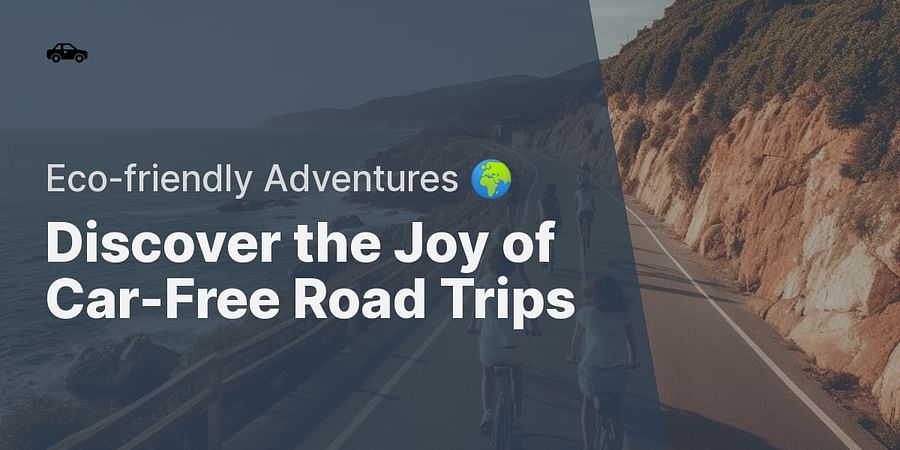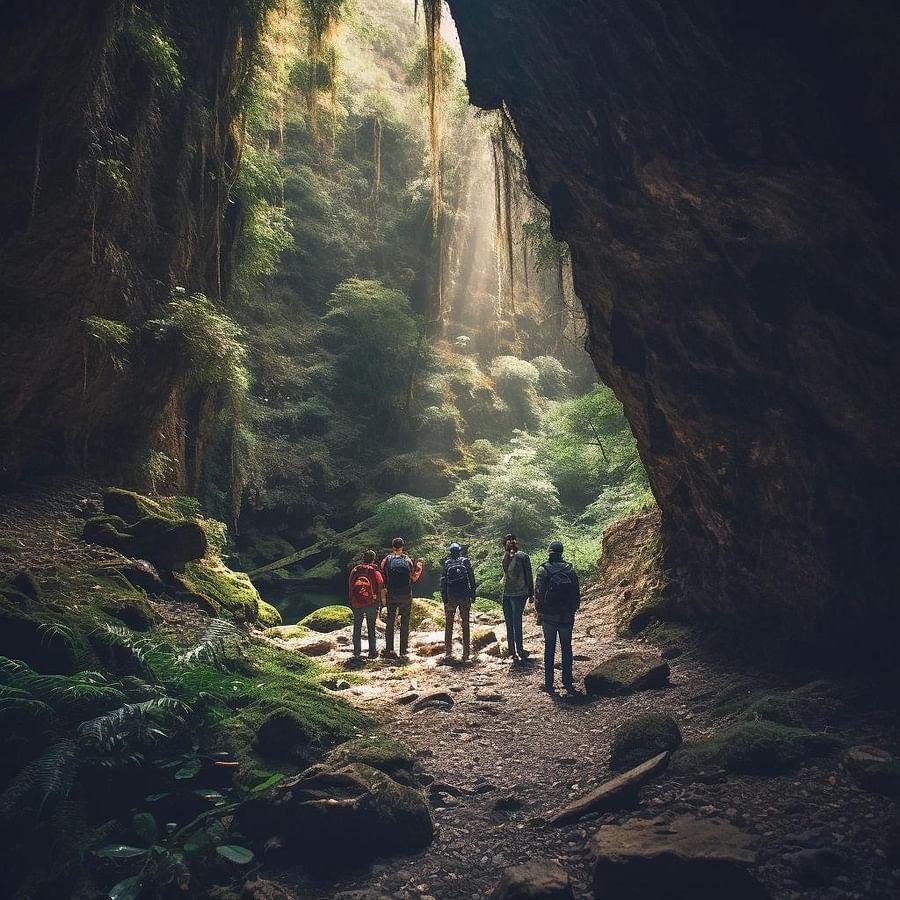Car-Free Road Trips: Exploring Destinations with Alternative Transportation Methods

When planning a road trip, the first thing that comes to mind is usually a car. However, there are plenty of reasons to consider alternative transportation methods for your next adventure. In this section, we'll explore the benefits of choosing alternative transportation for road trips and why it's worth considering.
1. Cost Savings
One of the primary reasons to choose alternative transportation is the potential for significant cost savings. Owning and maintaining a car can be expensive, and gas prices can add up quickly on long trips. By opting for alternative transportation methods like biking, walking, or taking public transit, you can save money on gas, parking, and maintenance costs.
2. Environmental Impact
Another important reason to consider alternative transportation is the reduced environmental impact. Cars are a major source of greenhouse gas emissions, contributing to climate change and air pollution. By choosing alternative transportation methods, you can reduce your carbon footprint and help protect the environment.
3. Health Benefits
Active transportation methods like biking and walking offer numerous health benefits. They provide an opportunity for regular exercise, reduce stress, and improve mental well-being. Plus, spending more time outdoors can lead to a greater appreciation for nature and the environment.
4. Discovering Hidden Gems
Traveling by car can limit your ability to explore off-the-beaten-path destinations. Alternative transportation methods often allow you to discover hidden gems that you might miss when driving. Whether it's a scenic bike trail, a picturesque walking path, or a unique public transit route, these alternative methods can lead to unforgettable experiences.
5. Connecting with Local Communities
Lastly, choosing alternative transportation can help you connect with local communities more authentically. When you're not confined to a car, you're more likely to engage with locals and experience the true culture of a destination. This can lead to a more enriching and memorable travel experience.
In conclusion, there are numerous reasons to consider alternative transportation for your next road trip. From cost savings and environmental benefits to health advantages and unique experiences, the rewards are well worth the effort. So why not give it a try on your next adventure?

National parks are some of the most beautiful and awe-inspiring destinations in the world. They offer a chance to connect with nature and experience the great outdoors. However, many people assume that a car is necessary to explore these parks. This is not true! Many alternative transportation methods can be used to explore national parks without a car.
One option is to take advantage of the park's shuttle system. Many national parks have shuttle buses that run throughout the park, stopping at popular destinations and trailheads. This is a great way to get around without having to worry about parking or navigating unfamiliar roads. Plus, it's a more sustainable option than driving your car.
Another option is to rent a bike. Many national parks have bike rental shops where you can rent a bike for a few hours or a full day. Biking is a great way to explore the park at your own pace and get some exercise at the same time. Just be sure to bring plenty of water and sunscreen, and be aware of any bike restrictions on trails.
Finally, hiking is always a great option for exploring national parks. Many parks have trails that range from easy to challenging, so there's something for everyone. Just be sure to bring appropriate footwear and plenty of water, and be aware of any trail closures or restrictions.
Exploring national parks without a car is not only possible, but it can also be a more enjoyable and sustainable way to experience these beautiful destinations. So next time you're planning a road trip, consider leaving the car behind and exploring national parks with alternative transportation methods.
Planning and preparing for a car-free road trip requires some additional considerations compared to traditional road trips. Here are some practical tips and advice to help you plan and prepare for a car-free road trip:
1. Choose the Right Destinations: Research destinations that have good public transportation networks or are known for being bike-friendly. Look for cities with comprehensive public transit systems, well-connected routes, and accessible attractions.
2. Plan Your Route: Map out your route using public transportation routes, bike lanes, or pedestrian-friendly paths. Identify transportation connections, schedules, and any transfers you may need to make. Consider using mobile apps or websites that provide real-time information on transit options and schedules.
3. Research Alternative Transportation Methods: Familiarize yourself with alternative transportation methods available at your destinations. This could include buses, trains, trams, ferries, bike-sharing programs, or electric scooters. Learn about ticketing systems, fares, and any special requirements for using these modes of transportation.
4. Pack Light: Since you won't have a car trunk to store your belongings, pack light and bring only essential items. Consider versatile clothing options, compact toiletries, and multipurpose gear. Use a backpack or suitcase with wheels for easy mobility.
5. Choose Accommodations with Accessible Transportation: Look for accommodations located near public transportation stops or bike-friendly areas. Consider staying in central locations that allow easy access to attractions and transportation hubs
6. Research Local Attractions and Activities: Identify attractions and activities that are easily accessible by alternative transportation methods. Consider visiting parks, museums, markets, or neighborhoods that are within walking or biking distance from your accommodations or transit stops.
7. Check Weather Forecasts: Stay updated on weather forecasts for your destinations. Pack appropriate clothing and gear for different weather conditions. Have raincoats, umbrellas, or sun protection items as needed.
8. Learn Basic Phrases: If traveling to a destination where English may not be widely spoken, learn some basic phrases in the local language. This can help with navigation, purchasing tickets, and interacting with locals.
9. Download Useful Apps: Download mobile apps that provide transportation information, maps, and language translation tools. Use apps that offer real-time public transportation schedules, bike-sharing locations, or walking directions.
10. Be Flexible and Open to Unexpected Experiences: Embrace the spirit of adventure and be flexible with your plans. Public transportation schedules may change, and you may come across unexpected attractions or activities along the way. Allow some flexibility in your itinerary to make the most of your car-free road trip
By following these tips and preparing accordingly, you can have a successful and enjoyable car-free road trip. Embrace the unique experiences and opportunities for sustainable travel that come with exploring the world without a car.
Bike touring is a great way to explore new destinations while getting some exercise and fresh air. Here are some tips to make your bike tour a success:
Plan your route: Before you hit the road, carefully plan your route. Consider the distance, terrain, and weather conditions. Make sure to choose a route that is safe and enjoyable.
Invest in a good bike: A good bike is essential for a successful bike tour. Invest in a comfortable, reliable bike that is suited to the terrain you will be riding on.
Pack light: When bike touring, it's important to pack light. Bring only the essentials, such as a change of clothes, a sleeping bag, and a tent. Consider packing lightweight and compact gear to save space.
Stay hydrated: When biking, it's important to stay hydrated. Bring plenty of water and plan your route around water sources.
Take breaks: Biking can be tiring, so make sure to take breaks and rest when needed. Use breaks to enjoy the scenery, take photos, and refuel with snacks.
Be prepared for emergencies: Accidents and emergencies can happen on a bike tour. Bring a first aid kit and know how to handle basic bike repairs.
Bike touring is a fun and eco-friendly way to explore new destinations. By following these tips, you can have a safe and enjoyable bike tour.
One of the most rewarding aspects of a car-free lifestyle is the opportunity to discover hidden gems on foot. When you're not confined to the limits of a vehicle, you can explore places that are often overlooked or inaccessible by car. Whether you're wandering through a quaint village, hiking a scenic trail, or strolling through a bustling city, walking allows you to fully immerse yourself in your surroundings and uncover unique experiences that you might have otherwise missed.
Walking tours are a fantastic way to get to know a new destination. Many cities and towns offer guided walking tours, which can provide valuable insight into the history, culture, and architecture of the area. Alternatively, you can also create your self-guided walking tour by researching points of interest and mapping out a route. Don't forget to leave room for spontaneous detours and stops along the way!

When planning your car-free road trip, consider incorporating hiking trails into your itinerary. Not only do these trails offer a chance to connect with nature and enjoy breathtaking views, but they can also lead you to hidden gems such as secluded beaches, waterfalls, and historic sites. Be sure to research trail difficulty and accessibility in advance, and always pack appropriate gear and supplies for your hike.
Another advantage of exploring on foot is the opportunity to engage with locals. Walking through neighborhoods and local markets allows you to interact with residents and gain a deeper understanding of their way of life. You might even receive recommendations for lesser-known attractions or hidden gems that are off the beaten path.
Ultimately, discovering hidden gems on foot is a rewarding experience that can enhance your car-free road trip. By slowing down and fully immersing yourself in your surroundings, you'll create lasting memories and uncover the true essence of the places you visit.
When it comes to exploring urban destinations, taking public transportation is not only a practical choice but also an eco-friendly one. In this section, we'll discuss the benefits of using public transportation on your car-free road trips and offer some tips on how to make the most of it.
Why Choose Public Transportation for Urban Destinations
There are several reasons why public transportation is an excellent choice for exploring urban destinations. First, it's often more affordable than renting a car or using ride-sharing services. Second, it allows you to avoid the stress of navigating unfamiliar streets and finding parking. Third, using public transportation is a more sustainable option, as it helps reduce traffic congestion and air pollution.
Tip: Research the public transportation options available in your destination city before you arrive. This will help you plan your itinerary and save time during your trip.
Maximizing Your Public Transportation Experience
Here are some tips to help you make the most of your public transportation experience:
1. Get a transit pass: Many cities offer daily, weekly, or monthly transit passes that provide unlimited rides on buses, subways, and other forms of public transportation. These passes can save you money and make it easier to hop on and off as you explore.
2. Use transit apps: Download a transit app for your destination city to help you plan routes, track arrival times, and find nearby stops. Some popular transit apps include Citymapper, Transit, and Moovit.
3. Travel during off-peak hours: To avoid crowded buses and trains, try to travel during off-peak hours when possible. This will make your journey more comfortable and enjoyable.
4. Be prepared for delays: Public transportation can sometimes be unpredictable, so be prepared for potential delays and have a backup plan in case of service disruptions.
5. Explore local neighborhoods: One of the best ways to experience a city is by exploring its diverse neighborhoods. Use public transportation to venture beyond the tourist hotspots and discover hidden gems off the beaten path.

By choosing public transportation for your urban road trips, you'll not only save money and reduce your environmental impact, but you'll also gain a deeper appreciation for the cities you visit. So, the next time you're planning a car-free adventure, consider taking the bus, train, or subway to explore your destination.
For many, the idea of camping and hiking without a car may seem daunting. However, with a little planning and creativity, it's entirely possible to enjoy the great outdoors without relying on a personal vehicle. In this section, we'll explore some tips and tricks for making your car-free camping and hiking adventures a reality.
Research Accessible Destinations
Start by researching campgrounds and hiking trails that are accessible by public transportation or within walking distance from your accommodation. Many national and state parks offer shuttle services or have nearby bus stops, making it easy to reach your desired destination without a car. Additionally, some parks even have campgrounds within walking distance of the entrance, eliminating the need for a vehicle.
Plan Your Gear Wisely
When camping and hiking without a car, it's essential to pack lightly and efficiently. Opt for lightweight, compact gear that can easily fit in a backpack or be carried on public transportation. Multi-purpose items, such as a camping stove that doubles as a charger, can help save space and weight in your pack. Don't forget to include a durable, reusable water bottle to stay hydrated during your adventures.
Utilize Bikepacking
If you're an avid cyclist, bikepacking is an excellent way to combine camping and hiking without a car. This method involves attaching your camping gear to your bike and cycling to your destination. Not only does this allow you to cover greater distances, but it also provides a unique and eco-friendly way to explore the outdoors. Be sure to research bike-friendly trails and campgrounds before setting off on your journey.
Join Organized Hiking and Camping Trips
For those who prefer a more structured approach, consider joining an organized hiking or camping trip. Many outdoor adventure companies offer guided excursions that include transportation to and from the trailhead or campground. This option is an excellent way to meet like-minded individuals, learn from experienced guides, and explore new destinations without the need for a car.
In conclusion, camping and hiking without a car is not only possible but can also lead to unique and memorable experiences. By researching accessible destinations, planning your gear wisely, and considering alternative methods such as backpacking or organized trips, you can enjoy the great outdoors while minimizing your environmental impact.
As more and more people become aware of the environmental impact of their daily lives, sustainable travel has gained significant traction. Reducing your carbon footprint by choosing alternative transportation methods for your road trips is not only a responsible choice, but it can also lead to a more fulfilling and unique travel experience. In this section, we will discuss the benefits of sustainable travel and how you can make a difference by opting for car-free road trips.
Why is sustainable travel important? The transportation sector is one of the largest contributors to greenhouse gas emissions, with cars being a major culprit. By choosing alternative transportation methods, such as biking, walking, or taking public transportation, you can significantly reduce your carbon footprint and help combat climate change. Additionally, sustainable travel often encourages a slower pace, allowing you to truly immerse yourself in the local culture and environment.

So, how can you make your road trips more sustainable? Here are some tips:
By embracing sustainable travel and reducing your carbon footprint, you can enjoy a more authentic and meaningful travel experience while also doing your part to protect our planet. So, the next time you plan a road trip, consider leaving the car behind and exploring the world through alternative transportation methods.
Embarking on a car-free road trip can be both challenging and rewarding. While it may require more planning and flexibility, the benefits of experiencing your journey through alternative transportation methods are well worth the effort. In this section, we'll discuss some of the challenges you may face and the rewards that make it all worthwhile.
Challenges
One of the primary challenges of a car-free road trip is the need for meticulous planning. You'll need to research transportation options, routes, and schedules to ensure a smooth journey. This can be time-consuming, but it's essential for a successful trip.
Another challenge is the potential for limited transportation options in certain areas. Some destinations may not have extensive public transportation systems, making it difficult to navigate without a car. In these cases, you may need to rely on alternative methods like biking or walking.
Lastly, traveling without a car can sometimes be more physically demanding. Whether you're biking, walking, or carrying your gear on public transportation, you'll need to be prepared for the added physical exertion.
Rewards
Despite the challenges, there are numerous rewards to be gained from car-free road trips. One of the most significant benefits is the opportunity to truly immerse yourself in your surroundings. Without the barrier of a car, you'll be more connected to the environment and the people you encounter along the way.
Car-free travel also allows you to discover hidden gems that may be inaccessible by car. Exploring on foot or by bike can lead you to off-the-beaten-path destinations that are often overlooked by those traveling by car.
Another reward is the positive impact on the environment. By choosing alternative transportation methods, you're reducing your carbon footprint and contributing to a more sustainable future.
Lastly, car-free road trips can be more cost-effective. With the rising costs of gas and car maintenance, opting for public transportation, biking, or walking can save you money in the long run.
In conclusion, while car-free road trips may present some challenges, the rewards of experiencing your journey through alternative transportation methods are well worth the effort. Embrace the adventure and enjoy the unique experiences that come with car-free travel.

Post a comment